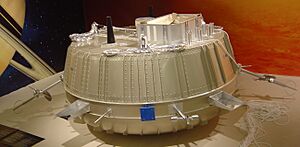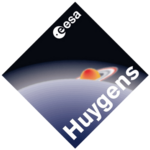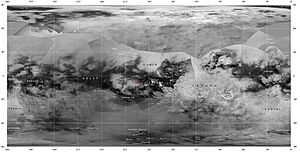Huygens (spacecraft) facts for kids

A full-size replica of the Huygens probe, 1.3 metres (4.3 feet) across
|
|
| Mission type | Titan lander |
|---|---|
| Operator | ESA / ASI / NASA |
| Website | Huygens home page |
| Spacecraft properties | |
| Manufacturer | Thales Alenia Space (then Aérospatiale) |
| BOL mass | 320 kg (710 lb) |
| Power | 1800 Wh total |
| Start of mission | |
| Launch date | 08:42, October 15, 1997 (UTC) |
| Rocket | Titan IV(401)B/ Centaur-T B-33 |
| Launch site | Cape Canaveral SLC-40 |
| Contractor | Lockheed Martin |
| Deployed from | Cassini |
| Deployment date | December 25, 2004 |
| End of mission | |
| Last contact | 13:37, January 14, 2005 (UTC) |
| Landing date | 12:43, January 14, 2005 (UTC) |
| Titan lander | |
| Landing date | 12:43, January 14, 2005 (SCET UTC) |
| Landing site | 10°34′23″S 192°20′06″W / 10.573°S 192.335°W |
 ESA quadrilateral mission insignia for Huygens |
|
The Huygens probe was a robotic space probe that made history. It successfully landed on Saturn's largest moon, Titan, in 2005. This was the first time any spacecraft had landed on Titan. It also became the farthest landing from Earth ever made.
The European Space Agency (ESA) built and operated Huygens. NASA helped launch it. Huygens was part of a bigger mission called Cassini–Huygens. The probe was named after Christiaan Huygens. He was a Dutch astronomer who discovered Titan in 1655.
The Cassini–Huygens spacecraft launched from Earth on October 15, 1997. Huygens separated from the Cassini orbiter on December 25, 2004. It then landed on Titan on January 14, 2005. This landing happened near a region called Adiri. So far, Huygens' landing is the only one in the outer Solar System. It is also the only landing on a moon other than Earth's.
Huygens landed on solid ground. However, its design allowed it to land in an ocean if needed. The probe was built to collect data for a few hours. It gathered information while falling through Titan's atmosphere. It also sent data for about 90 minutes after landing.
Contents
Exploring Titan: The Huygens Mission
Huygens was designed to enter Titan's atmosphere. It would slow down using a special heat shield. Then, it would use parachutes to float down. It was like a flying laboratory.
When the mission was planned, scientists weren't sure what Titan's surface was like. It could have been mountains, flat plains, or even an ocean. Data from the Cassini spacecraft helped answer these questions.
Pictures from Cassini showed the landing site. It looked like a shoreline. If the surface was liquid, Huygens was ready. It could survive splashing down. It would then send data from the liquid surface. This would have been the first time a probe landed in an extraterrestrial ocean.
The spacecraft had about three hours of battery life. Most of this was for the descent. Engineers hoped to get at least 30 minutes of data from the surface.
The Huygens probe weighed about 318 kg (701 lb). It had a heat shield 2.7 m (8.9 ft) wide. After the shield was dropped, the probe was 1.3 m (4.3 ft) wide. It also had support equipment. This equipment helped track the probe. It also collected and sent data to the Cassini orbiter. From there, the data went to Earth.
The probe stayed quiet during its 6.7-year journey to Saturn. It only woke up for quick checks. These checks made sure everything was working.
Before separating from Cassini, Huygens had a final check. It then detached and floated freely for 22 days. Its systems turned on 15 minutes before reaching Titan's atmosphere.
The main part of the mission was parachuting through Titan's atmosphere. The batteries were set for 153 minutes of operation. This included 2.5 hours of descent. It also allowed for at least 3 minutes on the surface. The probe's radio link turned on early. Cassini listened for three hours. This covered the descent and the first 30 minutes on the surface.
Large radio telescopes on Earth also listened. They used a special technique called very long baseline interferometry. This helped them detect Huygens' signal. Scientists used the signal's Doppler shifting to figure out wind speeds. They also pinpointed the landing site. The probe landed at 10°34′23″S 192°20′06″W / 10.573°S 192.335°W.
Discoveries on Titan's Surface
Huygens landed on January 14, 2005, at about 12:43 UTC. It hit the surface at a speed like dropping a ball from 1 m (3 ft) on Earth. It made a 12 cm (4.7 in) deep dent. Then, it bounced and slid 30 to 40 cm (12 to 16 in). The probe wobbled five times before stopping. Its sensors detected small movements for two more seconds. The impact also kicked up a cloud of dust. This dust stayed in the air for about four seconds.
At the landing site, scientists saw pebbles of water ice. They were scattered over an orange surface. This surface was mostly covered by a thin haze of methane. Early pictures from Huygens showed signs of large liquid areas. Photos before landing seemed to show drainage channels. These channels went from lighter land into a dark "sea." Some pictures even showed islands and a misty coastline.
Later analysis showed that Huygens landed in this dark "sea" area. The pictures from the surface looked like a dry lakebed. This suggests that liquid was active there recently. However, there might not be liquid hydrocarbon lakes at the landing site now.
Other data from the Cassini Mission confirmed liquid hydrocarbon lakes. These permanent lakes are in Titan's polar regions. Long-lasting tropical lakes were also found in 2012. One was near the Huygens landing site. It was about half the size of Utah's Great Salt Lake. It was at least 1 m (3 ft) deep. In dry desert areas, underground aquifers likely supply water. These are like "oases" in Titan's dry areas.
The surface was first thought to be like clay. It might have a thin crust over a soft, uniform layer. One scientist compared it to a crème brûlée. This is a dessert with a hard top and soft inside. Later analysis suggested that Huygens pushed a large pebble into the ground. The surface is better described as "sand" made of ice grains. It might be frozen snow.
The images taken after landing show a flat plain with pebbles. These pebbles might be water ice coated with hydrocarbons. They are somewhat rounded. This suggests that fluids shaped them. The rocks look rounded and sorted by size. This is like rocks in a stream bed. The stream bed is within a dark lakebed. This lakebed has finer material. No pebbles larger than 15 cm (5.9 in) were seen. Rocks smaller than 5 cm (2.0 in) are rare. This means large pebbles don't get to the lakebed. Small rocks are quickly removed.
The temperature at the landing site was 93.8 K (−179.3 °C; −290.8 °F). The pressure was 1,467.6 mbar (1.4484 atm). This means methane makes up about 5% of the air. The methane relative humidity was 50% near the surface. So, ground fogs from methane are unlikely. Thermometers showed that heat left Huygens quickly. This means the ground must have been damp. One image even shows light from a dewdrop falling across the camera.
On Titan, sunlight is very weak. Only about one centimeter of evaporation happens per year. On Earth, it's about one meter of water. But Titan's atmosphere can hold a lot of liquid. It can hold the equivalent of about 10 m (30 ft) of liquid before rain forms. On Earth, it's only a few centimeters. So, Titan's weather might have huge downpours. These could cause flash floods. But they would be followed by decades or centuries of drought.
Huygens found Titan's surface to be very dim. It was about one thousand times dimmer than full sunlight on Earth. Or, 500 times brighter than full moonlight. This is like the light level about ten minutes after sunset on Earth. The sky and scene on Titan look orange. This is because Titan's haze blocks blue light more than red light. The Sun would look like a small, bright spot. It would be one-tenth the size of the Sun seen from Earth. It would be like a car headlight seen from 150 m (500 ft). It casts sharp shadows, but they don't have much contrast. This is because 90% of the light comes from the sky.
Huygens Mission Timeline
- Huygens separated from the Cassini orbiter at 02:00 UTC on December 25, 2004.
- Huygens entered Titan's atmosphere at 10:13 UTC on January 14, 2005.
- The probe landed on Titan's surface around 12:43 UTC. This was 2 hours and 30 minutes after entering the atmosphere.
Just hours before landing, Earth and the Moon passed in front of the Sun. This was seen from Saturn and Titan. Huygens entered Titan's atmosphere about 2.7 hours after Earth's transit. This transit did not affect the mission. Huygens sent data to Cassini, not directly to Earth. Cassini then sent the data to Earth.
Huygens Instruments
Huygens carried six scientific instruments. They collected many types of data as the probe descended.
Huygens Atmospheric Structure Instrument (HASI)
This instrument measured the physical and electrical properties of Titan's atmosphere. It had accelerometers to measure forces. These helped determine the atmosphere's density and wind gusts. It also had temperature and pressure sensors. The HASI also included a microphone. This recorded any sounds during the descent and landing.
Doppler Wind Experiment (DWE)
This experiment used radio signals to measure Huygens' speed. This helped determine wind speeds and directions. Scientists could tell how the probe was moving horizontally. A problem with the Cassini orbiter meant some of this data was lost. But Earth-based radio telescopes helped get some of it back. Measurements showed strong winds high up. Near the ground, winds were gentle.
Descent Imager/Spectral Radiometer (DISR)
DISR was made to study how light moves through Titan's atmosphere. It had cameras and sensors to measure light. It took pictures as Huygens descended. It also measured how light scattered. This helped scientists learn about the haze particles. Three imagers took pictures of the landing site. These images became clear below 25 km (16 mi) altitude. Just before landing, a lamp turned on. This lit up the surface. It helped measure how the surface reflected light.
Gas Chromatograph Mass Spectrometer (GC/MS)
This instrument identified and measured chemicals in Titan's atmosphere. It collected samples at high altitudes. It also analyzed samples heated by another instrument. Finally, it measured the composition of Titan's surface. It did this by heating up just before impact. This vaporized the surface material for analysis.
Aerosol Collector and Pyrolyser (ACP)
The ACP collected tiny aerosol particles from the atmosphere. It used filters to trap them. Then, it heated the samples in ovens. This process, called pyrolysis, turned them into gas. These gases were then sent to the GC/MS for analysis. Two filters collected samples at different heights.
Surface Science Package (SSP)
The SSP had many sensors. They were designed to find out about Titan's surface. This included whether it was solid or liquid. An acoustic sounder measured the distance to the surface. It also measured how rough the surface was. If the surface was liquid, it would measure the speed of sound in the "ocean." It would also check the depth.
During descent, it measured the speed of sound. This gave information about the atmosphere. An accelerometer recorded the impact. This showed how hard the surface was. A tilt sensor measured the probe's movement. It also showed its position after landing. If the surface was liquid, other sensors would measure its density, temperature, and electrical properties. A penetrometer stuck out from the bottom. It measured the force as Huygens landed. This showed that the instrument hit an icy pebble.
Huygens Spacecraft Design
Huygens was built by Aérospatiale in France. This company is now part of Thales Alenia Space. The heat shield was also built in France.
Parachute System
Martin-Baker Space Systems was in charge of Huygens' parachute systems. They also handled the parts that controlled the probe's descent. IRVIN-GQ helped design the parachutes.
Fixing a Big Problem
Long after launch, engineers found a serious problem. The communication equipment on Cassini had a flaw. This could have caused all data from Huygens to be lost.
Huygens was too small to send data directly to Earth. So, it sent its data to Cassini. Cassini would then relay it to Earth. Some engineers worried this hadn't been tested enough. They pushed for more tests while Cassini was flying.
In 2000, they sent fake data to Cassini. It turned out Cassini couldn't relay the data correctly. This was because Huygens signal would change as it moved. Cassinis receiver was designed for this. But its software didn't account for how the signal's timing would change.
They couldn't reprogram the software. So, they had to change the mission's path. Huygens separated a month later than planned. It approached Titan in a way that reduced the signal change. This fix mostly solved the problem. Data transmission was successful. However, information from one of the two radio channels was lost due to a different error.
Lost Data Channel
Huygens was set to send data using two radio systems. They were called Channel A and B. Channel A was the only way to measure wind speeds. Pictures from the imager were split between the two channels. Each channel carried 350 pictures.
Cassini never listened to Channel A. This was because of a mistake in the commands sent to the spacecraft. The receiver on Cassini was never told to turn on. The European Space Agency said this was their error.
Because Channel A was not used, only 350 pictures were received. The other 350 were lost. All direct radio measurements between Cassini and Huygens were also lost. However, Earth-based radio telescopes still tracked Huygens. They helped calculate wind speeds and directions.
Citizen Scientists Help Out
Huygens rotated in the opposite direction than expected. This made it hard for the project team to create full pictures of the surface. But this also created an opportunity for "citizen science" projects. Regular people could try to put the images together.
The European Space Agency allowed the raw images to be published online. This let citizen scientists work with them. Many of these projects gained attention. While media sometimes said amateurs outperformed professionals, the goal was to explore Titan. Some enthusiasts were the first to publish panoramas of Titan. Another project worked for months. They matched almost all images to their correct positions. This resulted in detailed pictures and panoramas. One panorama from a citizen science project was even published in a science journal.
Landing Site
The probe landed on the surface of Titan at 10°34′23″S 192°20′06″W / 10.573°S 192.335°W.
See also
- Cassini–Huygens timeline
- Cassini retirement
- Europlanet
- List of missions to the outer planets
- Titan Mare Explorer
- Titan Saturn System Mission
- Galileo probe








